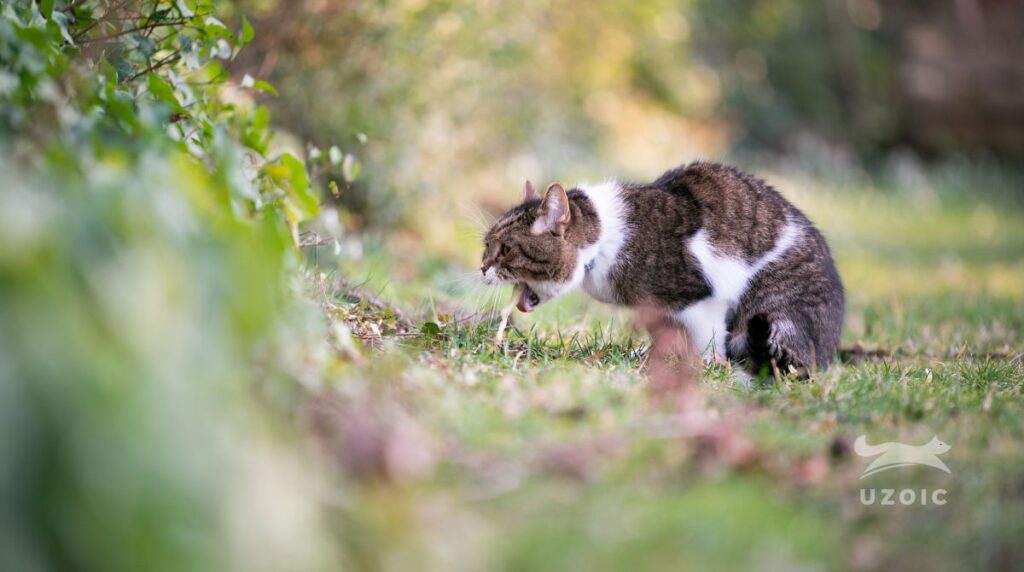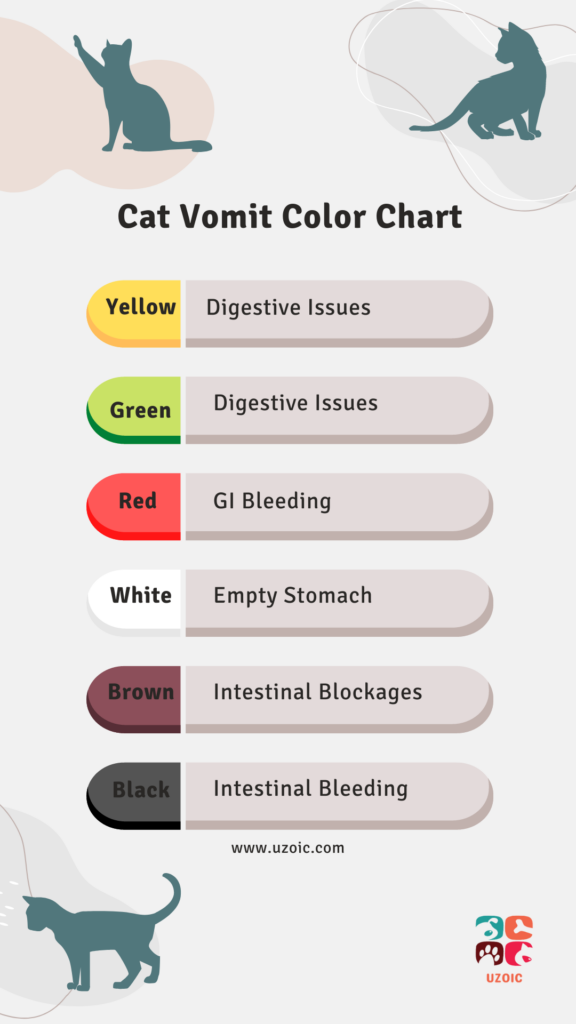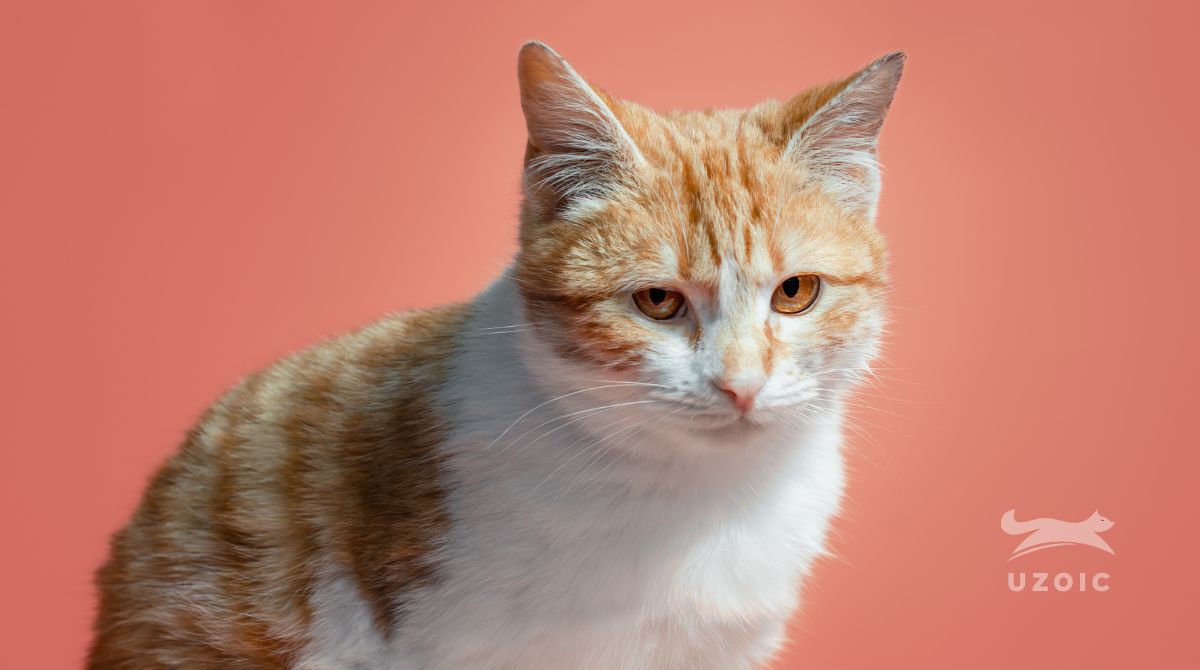Do you know what each color of cat vomit means? No? Well, you’re not alone. Most people don’t know the significance of each color when it comes to cat vomit.
This blog post will discuss each color’s meaning and how to interpret the cat vomit color chart.
If your cat vomits, it’s important to know what the colors mean to determine the cause of the vomiting and how to treat it.
By understanding the different colors, you will be able to better care for your cat and help them get healthy again! Keep reading for more information!
Cats vomit for various reasons, including hairballs, overeating, and intestinal parasites. Also, it is common for a cat to vomit hairball every other week.
While most of the time, vomiting is not a cause for concern, some colors can indicate a more serious problem.
While it’s important to know the significance of each color, it’s also important to remember that vomiting can also be caused by several other factors, such as stress, motion sickness, and certain medications.
Key elements of the cat vomit color chart includes yellow, green, red, white, brown and black. Yellow and green indicate presence of bile, red and shades of red, brown and black indicate blood or digested blood. White usually indicates empty stomach but foamy white can mean gastritis.
If your cat is frequently vomiting, it’s always best to consult your veterinarian to rule out any underlying medical conditions.
Table of Contents
Do Cats Vomit?

Vomiting is a reflex that occurs when the cat’s stomach is irritated.
The cat’s brain signals the muscles in the stomach to contract and expel the contents through the mouth.
Many things can irritate a cat’s stomach, including eating too fast, eating spoiled food, hairballs, and ingesting poisonous plants.
In addition, some medical conditions, such as liver disease, pancreatitis, and cancer, can lead to cat vomiting.
If your cat vomits more than once or twice a week, you should take him to the vet for a check-up.
What Does The Color Of Cat Vomit Mean?
The color of cat vomit can give you valuable clues about the cause of the vomiting.
For example, if your cat vomits clear liquid, it is likely due to an empty stomach or recent drinking.
On the other hand, if the cat vomit is yellow or green, it may indicate that it contains bile.
Bile is produced in the liver and stored in the gallbladder. It helps the cat digest fats.
If your cat has not eaten recently, this bile can build up in the stomach and lead to vomiting.
A Cat Vomit Color Chart

If you notice any of these colors in your cat’s vomit, it is important to take him to the vet for a check-up.
The vet can determine the cause of the vomiting and recommend the best course of treatment.
In most cases, cat vomiting is not a serious medical condition and can be treated at home.
However, if your cat is frequently vomiting or appears in pain, it is important to seek professional medical help.
What Does Abnormal Cat Vomit Look Like?
Abnormal cat vomit can take many forms, but some common characteristics can help you to identify it:
- Abnormal vomit usually contains traces of blood along with any undigested food or other materials, such as hairballs or grass, foreign objects such as strings or yarns, human food etc.
- The vomit may be bloody or tinged with green bile.
- It may have a foul odor.
- Your cat may act unwell in other ways, such as lethargy or loss of appetite.
If you notice any of these signs, you must take your cat to the veterinarian for an examination. With prompt treatment, most cases of vomiting can be resolved without serious complications.
Also, pay attention to the color of the cat vomit by referring to the cat vomit color chart above.
If it is green, yellow, or brown, this could indicate that your cat has ingested something that is causing them gastrointestinal distress.
Additionally, check the consistency of the vomit. If it is watery or bloody, this could be a sign of a more serious underlying condition.
Take note of how often your cat is vomiting. If they are vomiting multiple times per day or week, this could also indicate a health problem.
Causes
Vomiting is a very common symptom in cats and can have many different causes. It is important to note that not all vomiting is considered “abnormal.”
For example, some cats may vomit after eating too fast or if they have ingested something that disagrees with them.
However, if your cat is vomiting on a regular basis or if the vomit looks particularly abnormal, it could be a sign of a more serious problem.
Abnormal cat vomit may be bloody or coffee-colored and contain undigested food or other foreign objects.
If your cat is vomiting frequently or showing other signs of illness, it is important to take them to the vet for an evaluation.
When Should I Worry About Cat Puke?
Cat puke can be a gross and unpleasant sight, but usually, it’s not a cause for concern. If your cat is healthy and generally has a good appetite, then the occasional bout of vomiting is probably nothing to worry about.
Vomiting is a symptom of many feline illnesses and can range from being an occasional nuisance to a sign of a life-threatening condition.
So, when should you be concerned about your cat’s vomiting?
If your cat is vomiting once or twice a week, it’s probably nothing to worry about.
However, if vomiting becomes more frequent or is accompanied by other symptoms, such as weight loss, diarrhea, or lethargy, it could be a sign of a more serious problem, and you should take your cat to the vet.
Additionally, if your cat vomits blood or seems to be in pain while vomiting, this is a medical emergency, and you should seek veterinary care immediately.
By keeping an eye on your cat’s vomit, you can help to ensure their good health.
What Does Bile In Cat Vomit Look Like?
When a cat vomits, it can be alarming. However, it’s important to note that not all vomit is created equal.
In some cases, vomiting may simply result from an upset stomach or hairballs. However, if your cat is vomiting bile, it could signify a more serious problem.
Bile is a yellow-green fluid produced by the liver and stored in the gallbladder. It helps to break down fats in the digestive process.
When bile is present in vomit, it often looks like greenish-yellow slime.
Video of how cat vomit looks like:
If your cat is vomiting bile regularly, it’s important to consult with a veterinarian as soon as possible as it could be a sign of liver disease or other health problems.
Why Does My Cat Vomit So Much?
Frequent vomiting is a symptom of an underlying medical problem with your cat.
Cats vomit for many reasons. Some of the most common reasons are: eating too fast, eating something they shouldn’t have (like grass), stress or anxiety, hairballs, parasites, and certain medical conditions.
If your cat is vomiting occasionally and acting normally, it’s probably nothing to worry about.
However, if your cat is frequently vomiting or has other symptoms (like lethargy or loss of appetite, pain), it’s important to take them to the vet to rule out any serious medical conditions.
In the meantime, there are a few things you can do to help reduce vomiting:
- Feed smaller meals more often.
- Avoid dry food if possible.
- Brush your cat’s fur regularly to help reduce hairballs.
What Are The Different Colors Of Cat Vomit, And What Do They Mean?
As any cat owner knows, cats are prone to vomiting. However, not all vomit is created equal.
The color of your cat’s vomit can tell you a lot about their health.
Here are some of the most common colors of cat vomit and what they mean:
Yellow Cat Vomit: If your cat’s vomit is yellow, it may be a sign that they are suffering from liver disease. It can be yellow vomit with food, yellow paste or solid, foamy, hair, and yellow-green.
Green Cat Vomit: Green vomit may indicate an infection or inflammation in the digestive tract. It can also be a sign of liver disease.
Red Cat Vomit: Blood in vomit can signify several serious health problems, including gastrointestinal bleeding or liver disease.
If you see red vomit, take your cat to the vet immediately.
White Cat Vomit: White or clear vomit usually occurs on an empty stomach. It can be a sign of an empty stomach or food intolerance. Foamy white colored cat vomit indicates gastritis.
Brown Cat Vomit: See a vet in an emergency if your cat is vomiting brown liquid regularly. It could be from eating a foreign object that resulted in GI blockage.
Brown vomit is usually not from indigestion but may be from a serious disease such as a gastrointestinal tumor, fecal impaction, cancer, or blockages in the GI tract.
Black Cat Vomit: Coffee ground appearance could indicate bleeding in the stomach or intestines. It could also be due to food coloration.
Please note that the color of the food your cat has eaten will play a role in the color of the vomit.
For example, most kibbles are brown in color, so you will not be easily able to distinguish blood particles in them.
Therefore, we recommend that you place the vomit on tissue paper and go through the contents to identify the particles.
If you are concerned about the color of your cat’s vomit, always consult with a veterinarian for a diagnosis.
How Can You Tell If Your Cat Is Vomiting Due To A Serious Health Issue?
The frequency of vomiting and the color of the vomit provide clear indications that your cat may be vomiting due to a serious health issue.
In addition, you will notice observable behavioral changes in your cat if it is vomiting due to a health problem.
For example, your cat may have a decreased appetite, be lethargic, have trouble using the litter box or be in constant pain.
If you observe any changes in your cat’s behavior, take them to the vet for an evaluation.
What Should You Do If Your Cat Vomits Multiple Times In A Row?
Continuous or repeated vomit is a clear indication that your cat is sick. Please see the vet in an emergency.
How Can You Prevent Your Cat From Vomiting In The First Place?
The best way to prevent your cat from vomiting is to feed them a high-quality diet and avoid giving them table scraps.
Cats are known for their fast-eating habits. They bolt their food down without chewing and often end up vomiting soon after meals.
This behavior can be frustrating for owners, but there are some things you can do to help your cat eat more slowly.
One option is to invest in a slow-feeding bowl or a specially designed bowl that makes your cat work a little harder to get the food.
You can also try portioning your cat’s food and giving them several small meals throughout the day instead of one large one.
Finally, certain types of cat food contain enzymes that help to break down hairballs, which can reduce vomiting.
Taking these steps can help keep your cat’s digestive system on track and minimize vomiting.
To summarize, you can help prevent cat vomiting by:
- Slow Feeding
- Specialized Feeding Bowl
- Feed small portions
- Using cat food with hairball formula
- Brush their fur regularly to help reduce hairballs.
Are There Any Home Remedies For Treating Cat Vomit?
If your cat is vomiting, you can do a few things at home to help settle their stomach and ease nausea.
- Don’t give any food for 24 hours. Give small amounts of water frequently.
- Offer a bland diet consisting of boiled chicken after 24 hours in small quantities and continue for 3-5 days.
- If the vomiting stops, mix the boiled chicken with regular cat food and give this for another 5-7 days.
- Take care of your cat’s hydration during this period. They must remain well hydrated, so monitor their water intake.
- If vomiting continues, see a vet for diagnosis.
How Much Will It Cost To Treat A Vomiting Cat?
The cost of treating a vomiting cat will vary depending on the underlying cause, and it can range from $150 to $1500 in the U.S.
If your cat is simply experiencing an upset stomach, then you may be able to treat the problem at home by diet care.
However, if your cat is vomiting due to a more serious condition, such as GI blockages, liver disease, or cancer, treatment will likely be much more expensive.
In some cases, treatment may even require hospitalization. Therefore, it is important to consult with your veterinarian to determine the cause of your cat’s vomiting to make an informed treatment decision.
Most cat vomit cases do not require medical procedures.
Conclusion
In conclusion, the cat vomit color chart provides a guide to help determine the cause of your cat’s vomiting.
If your cat is vomiting due to an underlying health condition, it is important to seek treatment from your veterinarian.
In addition, you can do a few things at home to help settle your cat’s stomach, such as offering a bland diet and monitoring their water intake.
Now that you know the significance of each color, you can better determine the cause of your cat’s vomiting and how to treat it.
If you have any further questions, be sure to ask your veterinarian. They will be able to help you determine the best course of action for your cat.
So, there you have it! The next time your cat vomits, you’ll know precisely what to do!
Be sure to share this blog post with your friends and family so they can also stay informed! Thank you for reading 🙂
You may like:
- Why Does My Cat Squeak Instead Of Meow
- How To Use Coconut Oil For Cats Itchy Skin?
- Why Your Cat Is Squatting And How To Stop It
- Maggots In Cats Food: What to Do If You Find Worms in Your Cat’s Food
- How To Free A Cat Stuck In A Wall
- Do Cats Get More Affectionate With Age?
- How To Deal With Cat Depression After Getting A New Kitten
- Why Does My Kitten Play In The Litter Box?
- How To Treat Cat Dandruff With Olive Oil?
- Why Is My Cat Literally Obsessed With Me?


